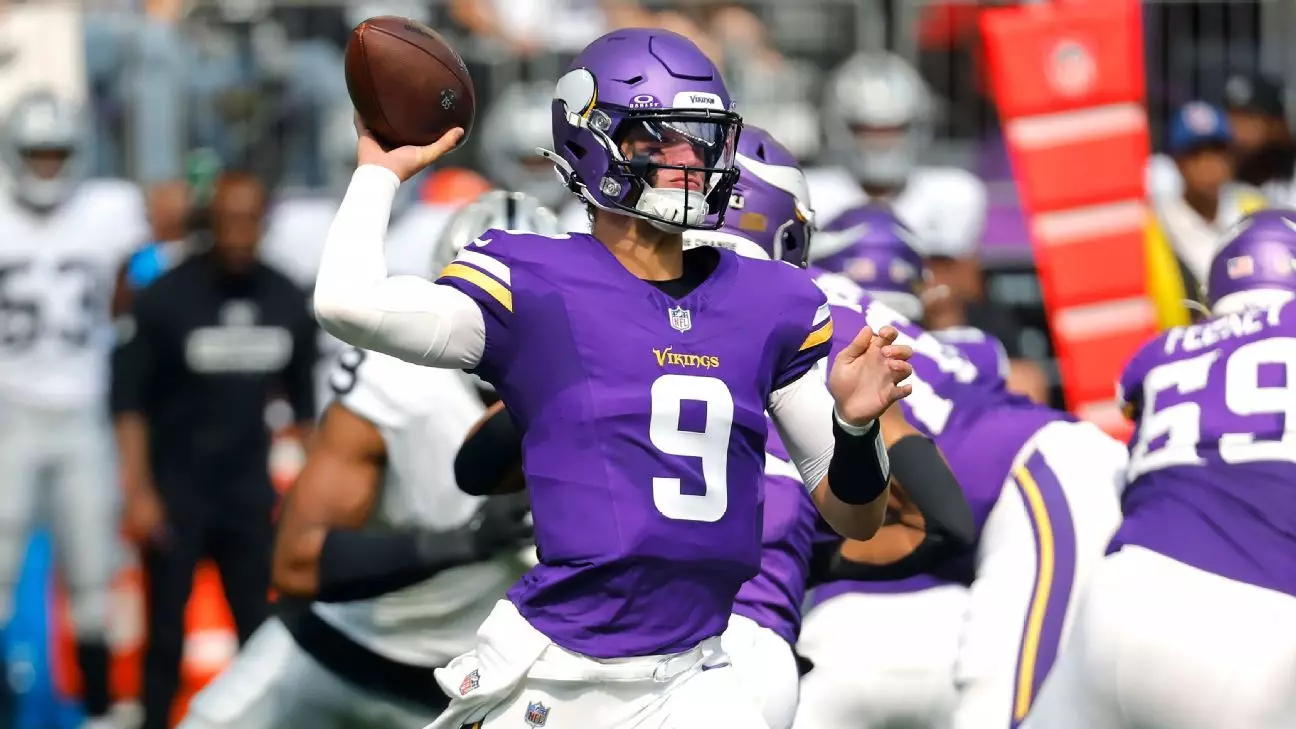The Minnesota Vikings are steering their franchise into a new era, firmly placing their faith in the budding talent of second-year quarterback J.J. McCarthy. Recent developments have signaled a decisive move away from veteran quarterbacks like Aaron Rodgers, illustrating a larger strategy aimed at nurturing young players and building a championship-caliber roster. Although there were discussions around bringing in a proven leader like Rodgers, the organization is opting for continuity and development, paving the way for McCarthy to seize his moment on the field.
While it may seem like a gamble to some, this decision is a testament to the franchise’s vision. After an exhaustive period of deliberations about acquiring Rodgers—who has undeniably made his mark in the league—the Vikings ultimately prioritized a coherent path forward. Amidst the complexities of recent free agency, including the departure of Sam Darnold to the Seattle Seahawks and Daniel Jones signing with the Indianapolis Colts, Minnesota’s choice to promote McCarthy illustrates a commendable leap of faith.
Goodbye to the Past
The departure of established quarterbacks creates an interesting void that the Vikings are not only recognized to overcome, but are actively addressing. McCarthy’s recovery from a torn meniscus has put him back on track, and now he stands as the focal point within a franchise eager to provide him with the necessary support to blossom into a franchise quarterback. Despite receiving trade interest, the Vikings’ management has shown prudence by turning down offers—a strategic decision that suggests they’re treating McCarthy as an irreplaceable asset.
Many football analysts argue that the Vikings have wisely chosen to avoid repeating the mistakes of the past, choosing instead to invest in the future. By not pursuing a short-term fix in the form of another veteran like Rodgers, the organization is signaling an earnest commitment to the development of their young star. Coach Kevin O’Connell’s declarations about McCarthy being the franchise’s future reflect a growth-oriented ethos, emphasizing continuity over flashes of fame.
The Building Blocks of Success
With an eye towards the future, the Vikings have invested significantly in retooling their roster. An impressive $300 million devoted to free agency hints at ambitious plans that directly align with supporting McCarthy. As Minnesota pivots to surround their young quarterback with ample talent, it positions the franchise for future success, rather than chasing fleeting victories that a veteran quarterback might promise.
Strengthening the offensive units is paramount, and while it remains crucial to identify a reliable veteran backup, the current discussion surrounding names like Joe Flacco, Carson Wentz, and even the ex-Vikings starter Kirk Cousins reflects a flexible, hungry mindset. The roster restructuring aims not only to bolster the depth chart but also to create a thriving ecosystem conducive to McCarthy’s growth as a leader on the field.
A Calculated Risk and Reward
As the offseason unfolds, the upside of aligning with a young, adaptable star like McCarthy unmistakably outweighs the uncertainty of a brief window of opportunity offered by pursuing veterans. While some critics might view the Vikings’ choices as reckless, defenders of this strategic pivot argue that consistent investment in developing talent proves essential for long-term success in the NFL.
In a league that often emphasizes immediate results, emphasizing patient growth could be precisely what the Vikings need. McCarthy’s untested status might evoke concern among fans and analysts, but investing his development fosters not only team loyalty but also a sense of ownership in the franchise’s future—the kind of investment that can pay dividends in wins and stability in the long run.
Moreover, as the Vikings prepare for offseason workouts and minicamps, providing McCarthy with first-team snaps positions him to engage deeply with the offensive unit, laying the groundwork for a season that melds youthful energy with tactical experience. The future of the franchise seems brighter under the guidance of a dedicated organization that believes in nurturing talent rather than hastily trying to solve limitations with short-term solutions.
With all these elements contributing to a substantial belief in McCarthy’s potential, the Minnesota Vikings written narrative may very well shift to a story of resurgence—a franchise tussling against the odds, betting on its young talent, and striving to reclaim its place at the top of the NFL landscape.

